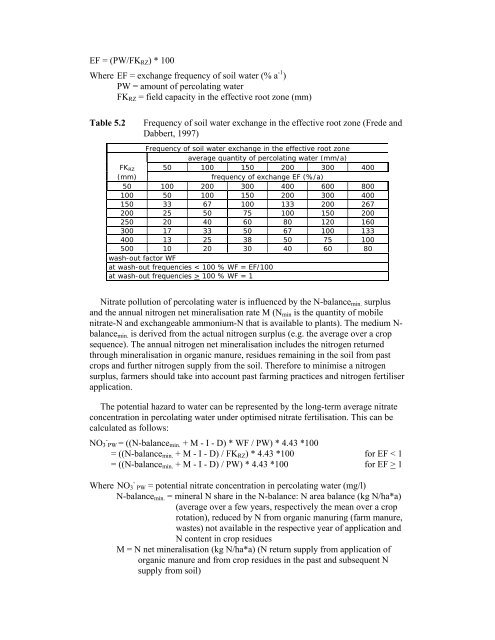Rolling Revision of the WHO Guidelines for Drinking-Water Quality ...
Rolling Revision of the WHO Guidelines for Drinking-Water Quality ...
Rolling Revision of the WHO Guidelines for Drinking-Water Quality ...
Create successful ePaper yourself
Turn your PDF publications into a flip-book with our unique Google optimized e-Paper software.
EF = (PW/FKRZ) * 100<br />
Where EF = exchange frequency <strong>of</strong> soil water (% a -1 )<br />
PW = amount <strong>of</strong> percolating water<br />
FKRZ = field capacity in <strong>the</strong> effective root zone (mm)<br />
Table 5.2 Frequency <strong>of</strong> soil water exchange in <strong>the</strong> effective root zone (Frede and<br />
Dabbert, 1997)<br />
Frequency <strong>of</strong> soil water exchange in <strong>the</strong> effective root zone<br />
average quantity <strong>of</strong> percolating water (mm/a)<br />
FKRZ 50 100 150 200 300 400<br />
(mm) frequency <strong>of</strong> exchange EF (%/a)<br />
50 100 200 300 400 600 800<br />
100 50 100 150 200 300 400<br />
150 33 67 100 133 200 267<br />
200 25 50 75 100 150 200<br />
250 20 40 60 80 120 160<br />
300 17 33 50 67 100 133<br />
400 13 25 38 50 75 100<br />
500 10 20 30 40 60 80<br />
wash-out factor WF<br />
at wash-out frequencies < 100 % WF = EF/100<br />
at wash-out frequencies > 100 % WF = 1<br />
Nitrate pollution <strong>of</strong> percolating water is influenced by <strong>the</strong> N-balancemin. surplus<br />
and <strong>the</strong> annual nitrogen net mineralisation rate M (Nmin is <strong>the</strong> quantity <strong>of</strong> mobile<br />
nitrate-N and exchangeable ammonium-N that is available to plants). The medium Nbalancemin.<br />
is derived from <strong>the</strong> actual nitrogen surplus (e.g. <strong>the</strong> average over a crop<br />
sequence). The annual nitrogen net mineralisation includes <strong>the</strong> nitrogen returned<br />
through mineralisation in organic manure, residues remaining in <strong>the</strong> soil from past<br />
crops and fur<strong>the</strong>r nitrogen supply from <strong>the</strong> soil. There<strong>for</strong>e to minimise a nitrogen<br />
surplus, farmers should take into account past farming practices and nitrogen fertiliser<br />
application.<br />
The potential hazard to water can be represented by <strong>the</strong> long-term average nitrate<br />
concentration in percolating water under optimised nitrate fertilisation. This can be<br />
calculated as follows:<br />
NO3 - PW = ((N-balancemin. + M - I - D) * WF / PW) * 4.43 *100<br />
= ((N-balancemin. + M - I - D) / FKRZ) * 4.43 *100 <strong>for</strong> EF < 1<br />
= ((N-balancemin. + M - I - D) / PW) * 4.43 *100 <strong>for</strong> EF > 1<br />
Where NO3 - PW = potential nitrate concentration in percolating water (mg/l)<br />
N-balancemin. = mineral N share in <strong>the</strong> N-balance: N area balance (kg N/ha*a)<br />
(average over a few years, respectively <strong>the</strong> mean over a crop<br />
rotation), reduced by N from organic manuring (farm manure,<br />
wastes) not available in <strong>the</strong> respective year <strong>of</strong> application and<br />
N content in crop residues<br />
M = N net mineralisation (kg N/ha*a) (N return supply from application <strong>of</strong><br />
organic manure and from crop residues in <strong>the</strong> past and subsequent N<br />
supply from soil)

















